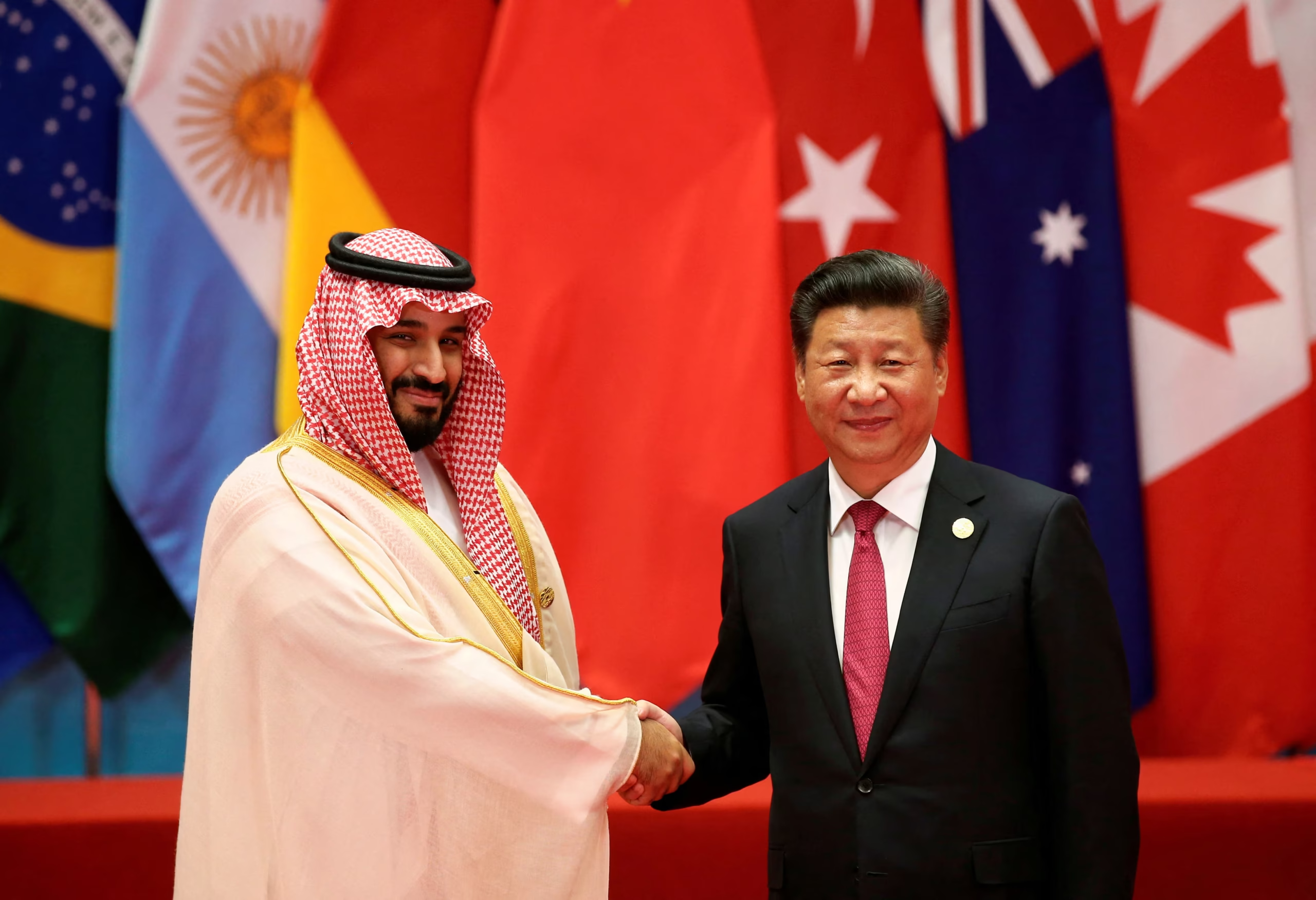21 October 2025, NIICE Commentary 11861
Reeba Khan
'Seek Knowledge Even as Far as China'- a quote by Prophet Muhammad, the most significant leader in the history of the Arab civilization. The quote signifies the importance of education and emphasizes on seeking valuable education, even if one has to go to China to procure it. Even in contemporary times, the ever-growing ties between Saudi Arabia and China reflect the similar solidarity- camel ready to venture, the land of the dragons. While Saudi Arabia is looking ahead to diversifying its relations in the east, with its “Look East Policy”, which goes hand in hand with its most cherished project, the “Vision 2030”. But why does Saudi Arabia’s Look East Policy go hand in hand with Vision 2030? And how does it interest China?
There is no denying that both countries are in a symbiotic relationship, benefiting each other’s mutual interests. Recently, the event, titled "Saudi-China Dialogue and Exchange on Modernization," the Xinhua news agency reported that the Saudi-Chinese partnership has entered a more mature phase, injecting new momentum into both nations' modernization processes, according to Saudi experts at a recent academic seminar held in Riyadh, Saudi Arabia. The deepening of the strategic partnership between the two becomes crucial as both Saudi Arabia and China seek to shift the global order and emerge as strong powers in the Middle East and Asia, respectively.
Understanding the Geopolitics of Oil
As Trump tariffs and Western sanctions continue to threaten the PRC, Beijing focuses on energy security amid prevailing geopolitical vulnerability. Recently, China has been stockpiling barrels of crude oil, expanding its storage capacity —a firm move under the lens of energy security. While China gets a healthy flow of crude oil from Russia and Iran, Western sanctions might cause interference. Saudi Arabia is emerging as one of China’s most significant trading partners, with trade volume between the two countries reaching $100bn in 2023. China represents nearly 20 per cent of the total oil export volume from Saudi Arabia.
Last year, Saudi Arabia expressed its openness regarding renminbi-based oil trade, which aligns with China’s aim to internationalize the Chinese Yuan. This plays out in favor of China, as it represents a clear-cut challenge to the hegemony of the petrodollar. For the Chinese yuan to become the currency of choice for trade between the two countries may take time, but Saudi Arabia’s willingness to accept the Yuan as the currency for oil trade creates a significant gateway for the world of the Petroyuan and demonstrates strength and understanding between the two.
Enhancing Strategic Ties: Fostering Cooperation and Cultural Ties
The year 2025 marks the 35th anniversary of the establishment of diplomatic relations between China and the Kingdom of Saudi Arabia. The two countries are holding a series of exciting cultural exchange activities under the framework of the "Saudi–Chinese Cultural Year.” The profound relationship plays an important role in preserving the ties between the two ancient civilizations.
Recently, the Mid-Autumn Festival reception was held in Riyadh, Saudi Arabia. Prince Bader bin Abdullah bin Farhan Al Saud, Saudi Arabia's Minister of Culture, stated that in November, Riyadh will host the world's largest light art festival—the fifth edition of 'Noor Riyadh' warmly welcoming Chinese friends to come to Saudi Arabia and experience it. Saudi films will be screened in China for the first time in late October, starting in Beijing, Shanghai, and Suzhou, in an attempt to strengthen cultural ties.
Since 2023, the frequency of direct flights between Beijing and Riyadh has increased, and plans to add more routes are in order. While the frequency of flight increases, directly proportional to this lies tourism.
Tourism plays an important role in strengthening cross-cultural ties. The Crown Prince Mohammad bin Salman, to diversify the country’s economy according to his national plan “Saudi Arabia’s Vision 2030”, identified tourism as the top industry after oil and energy. Riyadh aimed to increase tourism’s contribution to GDP from 3.5 percent in 2019 to 10 percent by 2030, targeting $46 billion in revenue. To improve cultural exchanges between the two polities, tourism becomes an important sector to focus on and contributes not only in economic terms but also in cultural terms, especially in the spread of culture and ideas, resulting in increasing tolerance between different communities and appreciation of culture, which later helps in better and prosperous ties between the countries.
Another initiative to support cultural exchanges is the Prince Mohammad bin Salman Award for Cultural Cooperation, which was announced in 2024. This year marks the first year of the annual award. While a multifaceted approach is taken to improve cultural and people-to-people ties, a new aspect to it has also emerged; China and Saudi Arabia will hold a joint naval training codenamed "Blue Sword-2025" in Saudi Arabia in October.
Synergy between Saudi Arabia's Vision 2030 and the Belt and Road Initiative
Beijing seeks to establish a new international order; this is evident as we attempt to grasp the essence of Chinese foreign policy. One of the main pillars, “building a community of shared future of mankind”, expresses Beijing’s desire to build relations with major powers and take the road that leads to global governance, hence marking itself as a frontrunner in the contemporary shifting global dynamics.
To successfully exist in the Middle East and maintain its hold in the region, China needs Saudi support; hence, it looks for mutual understanding.
The Belt and Road Initiative and Saudi Arabia's Vision 2030 are deeply integrated, driving practical economic and trade cooperation between the two countries to a new level. In regard to the Saudi-Sino Economic partnership, China is Saudi Arabia's largest trading partner, while Saudi Arabia has for many years remained China's top trading partner in the Arab region. In the first half of this year, bilateral trade reached 53.9 billion US dollars.
Aiming to reduce its dependency on hydrocarbon reserves, a key initiative of Saudi Arabia’s Vision 2030, which seeks to promote economic diversification in the Kingdom, is to boost its Foreign Direct Investment (FDI) in the industrial sector. The frequency of high-level talks between the two has increased since the announcement of the BRI in 2013, expressing mutual interest, centered on the Saudi-Sino Economic Partnership.
For China, Saudi Arabia is more than just oil; it's a link that connects it to Eurasia and the MENA region. China seeks to expand and deepen its economic and technological ties with the region; hence, it quickly endorsed Saudi Arabia’s Vision 2030, as it hoped for an alignment between the two projects, increasing investments and trade.
While Saudi Arabia is looking to diversify its economy and is keen on renewable energy, also expanding its global market and aims to improve its water security. China acts as a perfect guide. With Beijing’s state-of-the-art technology, China’s alignment with Vision 2030 is manifested by investments and contracts, mainly in the renewable energy sector, where China thrives. This commitment to supporting the Vision 2030 ambitious goals to diversify the economy and, on the same hand, look ahead to achieve sustainable development. By localizing industries and investing in cutting-edge technologies, China is assisting Saudi Arabia in reducing its oil dependency and establishing its presence in the Middle East.
China and Saudi Arabia are encouraging each other by enhancing cultural ties, fostering cooperation, investing, and aiming to integrate themselves into the global economy. It will be interesting to see what the future holds for Beijing and Riyadh, and their everlasting trusted partnership.
Reeba Khan is a Research Intern at NIICE & is currently pursuing her undergraduate degree in Chinese at Jawaharlal Nehru University, New Delhi, India.

